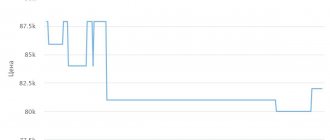Android Version 1.5: Cupcake
From now on, all future versions of Android will be named after sweets. In this case, the initial letter must be the next one in the alphabet.
On April 30, 2009, a new version of Android was released - 1.5, Cupcake. The most famous innovations of this version, among other things, were automatic switching between portrait and landscape display orientations and its own on-screen keyboard.
Android Versions 2.0-2.1: Éclair
Since Android 2.0, not every system update automatically resulted in the release of a new major version. Instead, starting in October 2009, for each major version, several subversions began to appear, modified, but at the same time bearing the name of the main system.
On October 26, 2009, Android 2.0 version called Éclair was released as an update. Digital zoom was presented here, and support for LED flash was also introduced.
On December 3, 2009, Android version 2.0.1 was released, which fixed some bugs.
On 01/07/2010 an update to version 2.1 appeared. Among other innovations, it made it possible to use animated (“live”) wallpapers.
Android 2.0 "Eclair"
The new version of Android with the tasty name “Eclair”, released in October 2009, received hardware acceleration, a search function for text and multimedia messages, support for live wallpapers, new maps and a calendar. There is flash support, quick access to contacts, tethering (distributing the Internet via Wi-Fi), automatic updating, voice dialing via Bluetooth, support for Adobe Flash 10.2, clipboard, support for sensors and sensors, support for multiple cameras.
At the same time, the developers updated the interface and introduced support for multiple cameras. In intermediate versions, additional functions were introduced to increase screen resolution, support multiple touches, and increase productivity. Work was also carried out to eliminate errors in various modules and applications. A fair number of users have seen smartphones and tablets running Android 2.0 and intermediate versions.
The most widely used intermediate versions are Android 2.2 and Android 2.3 – devices based on these versions were produced even in 2014.
The advantage of Android 2.0 and its intermediate versions is a noticeable speedup. It has also become possible to produce devices with higher screen resolutions (up to 720p). The disadvantage of the system was its not very convenient user interface. There was also no support for keyboards, mice and other input devices.
Android 2.2 Froyo
The version became faster, it expanded the Bluetooth functionality - it became possible to transfer contacts and carry out voice dialing (at that time even simple phones could do this). The same version introduced Internet distribution via Wi- Fi and a USB cable. Support for Adobe Flash 10.2 has also been implemented.
Android 2.3 Gingerbread
One of the most popular intermediate versions in the past. Its features:
- Updated interface;
- Support for the SIP protocol has appeared;
- NFC support has appeared;
- Launched the clipboard for copy and paste operations;
- Sensor support;
- Multiple camera support.
It also added sound effects and support for ultra-high resolution screens. Minor improvements and corrections were introduced in subsequent subversions.
Android Version 2.3: Gingerbread
On December 6, 2010, version Android 2.3, also known as Gingerbread, appeared. Starting in the OS, support for Near Field Communication (NFC) appeared, and its own operational download manager was added.
Then in December 2010, Android version 2.3.1 appeared, which fixed some bugs and contained an update to Google Maps 5.0.
In January 2011, Android version 2.3.2 appeared. It fixed a bug with the SMS service.
Android 2.3.3 was released on February 23, 2011, introducing the ability to equip Android devices with a dual-core processor.
On April 29, 2011, with an update to 2.3.4, the Google Talk application appeared, with the help of which video and voice chat became possible.
Finally, Android 2.3.5 was released on 07/08/2011 and some bugs were fixed. Also, the two subsequent additional versions 2.3.6 (09/02/2011) and 2.3.7 (09/20/2011) contained corrections of system defects.
Android version 3.x: Honeycomb
As of 02/23/2011, Gingerbread was replaced by Android 3.0, also known as Honeycomb. In the new version of the system, the interface has become more convenient, and the developers have also optimized it for working from a tablet. In addition, the Google Chrome browser has new features (for example, incognito mode).
On May 10, 2011, the first Honeycomb update to Android 3.1 was released. It added USB Host mode, and improved the interface and widgets. Version Android 3.2 was released on July 16, 2011, where images were optimized for various screen diagonals. Latest version of Honeycomb 3.2.1, some bugs were fixed, released 09/20/2011.
Android 3.0 Honeycomb
Honeycomb is a transition from Android to Holo UI, where the interface is made in dark colors with neon blue accents. The green robot transformed into the form of a bee in honor of the name Honeycomb. The overall color scheme of the system was inspired by the movie Tron: Legacy.
The secret is placed on the wallpaper of your home screen, so your background will be different.
How to Access Android 3.0 Honeycomb Easter Eggs
Go to Settings → About Phone and then tap the Android Version box several times until the Easter egg appears. The “REZZZZZZZ...” pop-up message should appear on its own shortly after activation.
Android Version 4.0: Ice Cream Sandwich
On 10/19/2011, a version of Android 4.0 called Ice Cream Sandwich (ICS) became available. Here, among other things, unlocking using facial recognition has been added, and many improvements have been made in small things.
On November 17, 2011, version 4.0.1 appeared, where the volume control error was fixed. Version 4.0.2, which became available starting December 15, 2011, introduced new improvements (for example, a new unlocking method), and also stopped supporting DivX.
The two latest updates to ICS version 4.0.3 (12/16/2011) and 4.0.4 (02/04/2012) brought further improvements. For example, in version 4.0.4 the overall volume level was increased.
Downloading sources
The listed manipulations for setting up the system are valid for building any version and any modification of Android. Our further actions already depend on our desires. As an example, let's start with the AOSP build for the Galaxy Nexus. This is the most typical option. To do this, we will create a directory (you can call it whatever you like, it’s not important), in which the source code will actually be located:
$ mkdir -p android/system $ cd android/system
Next, you need to initialize the repository using repo:
$ repo init -u \ https://android.googlesource.com/platform/manifest
At this stage, repo will ask you to enter your name and e-mail, which is not at all necessary. By default, the repo will be configured to the master branch of the specified repository (this is the latest version of the system). If you need sources of a different version, specify it using the '-b' switch. For example:
$ repo init -u \ https://android.googlesource.com/platform/manifest \ -b android-4.0.1_r1
Next, you can start downloading files:
$reposync
To download in multiple threads, you can specify the -j# option, where # is the number of threads. The download process itself is quite long (on a 1 Mb/s channel the download took more than three hours), so you can calmly go about your business. If the download is interrupted, it will be enough to perform “repo sync” again to restore it from the interrupted point. After the download is complete, a message like “Syncing work tree: 100% (305/305) done” will be displayed on the screen (see screenshot 1). This means that you can already start assembling.
Screenshot 1. Successful download of sources
Other articles in the issue:
Hacker #168. Spoofing in the air
- Contents of the issue
- Subscription to "Hacker"
Android Version 4.1: Jelly Bean
On June 27, 2012, Android 4.1 version called Jelly Bean was released. This update brings significant improvements to the user interface. In addition, the Google Now service was integrated into the system.
Starting with version 4.1.1 dated July 11, 2012, Google’s payment service, Google Wallet, was integrated into the system.
4.1.2 (released October 10, 2012) introduced the ability to manage notifications using gestures.
11/13/2012 - with version 4.2 - system streaming (Miracast) became available. In addition, other security updates have been introduced. In 4.2.1, released on November 27, 2012, some bugs were fixed.
4.2.2 (released on February 12, 2013) made it possible to install widgets directly on the lock screen.
Version 4.3 (released July 24, 2013) introduced many other innovations. Thus, it introduced limited accounts for children, and the Camera application was improved.
The latest Jelly Bean update was released on 10/04/2013 under number 4.3.1. Some minor bugs have just been fixed here.
Android 7.0 Nuga Easter Egg
In Android 7.0 Nougat, the Easter egg is implemented in a very funny way: there is a cat that you can feed from a plate with several types of dishes. You can access this Easter egg like this:
- Go to the settings menu;
- Click on the inscription “About phone”;
- Now tap on the Android version until the letter N appears on the screen;
- A cat head icon should appear directly below the N.
Do you see the cat?
Then you are ready. When the cat's head appears, it means you have successfully activated the Nuga Easter Egg. But you're not done yet, as there are a few more steps:
- Open the quick settings menu (pull down twice from the top of the display);
- Click on the “Edit” icon;
- Drag the new Empty Dish icon to your notification panel.
No Flappy Bird this time - unless you count the chicken.
Now you can attract cats. To do this, click on the empty dish icon to select the bait of your choice and wait. When the cat comes to the dish, you will be notified. You can even give the cat a name and share it with your friends. The cat will disappear after a while.
You have a visitor.
Android Version 4.4: KitKat
On October 31, 2013, Android 4.4, called KitKat, was released as a successor to Jelly Bean. A significant innovation was the removal of the limit to five home screens. Additionally, the Google+ Hangouts app can now be selected as an alternative for SMS.
On December 6, 2013, the first update to version 4.4.1 followed. The Camera app has been slightly redesigned here, along with some minor bug fixes.
Android version 4.4.2 appeared on 12/09/2013. The changes also concerned mainly bug fixes.
06/02/2014 4.4.3 was released: a known bug that caused a loss of network connection was fixed.
The latest update for KitKat is version 4.4.4. — followed by 06/19/2014.
Android 4.4 KitKat Easter Egg
The Easter egg in Android 4 KitKat pays homage to all past versions of Android. Go to Settings > About phone and tap on Android version several times. A spinning K will appear, which you can press and hold to bring up the KitKat logo. Press and hold it and a board will appear with colored tiles with logos from previous versions of Android.
To photo 10: Touch and hold the KitKat icon to see brightly colored tiles and images.
Touch and hold the KitKat icon to see brightly colored tiles and images.
Android Version 5: Lollipop
On November 3, 2014, a new version of Android 5.0 appeared, called Lollipop. It has changed the notification panel, the so-called “curtain”. In addition, this version is now used for most smartwatches.
5.0.1 (released 12/02/2014) was mainly optimized for Android Wear use.
On December 19, 2014, the Android 5.0.2 update appeared, which corrected errors. Android 5.1 has been available since 03/09/2014. Changes have been made here to make the system more stable.
The latest version of Android 5.1.1 to date was released on April 22, 2015 and is again aimed at correcting errors.
Android 5.0 Lollipop
In this version of the OS, secret was a real game. Initially, everything is quite nondescript - a large lollipop changes colors when pressed. But in the second part the real fun begins.
This is a Flappy Bird game, but in Android style. Instead of a bird there is a green robot, instead of pipes there are candies.
How to access Android 5.0 Lollipop Easter eggs
Go to Settings → About Phone and then tap the Android Version box several times until the Lollipop logo appears. Press and hold your finger on the lollipop to enter the Flappy Bird style game.
Android 6.0: Marshmallow
At a Google event held on September 29, 2020, the latest operating system was presented to the public. In August, Google already released a Developer Preview version of Marshmallow, which already gave a good idea of the new features of Android 6.0. The system was first presented on Nexus phones, and then on top-end devices from other manufacturers.
The system has implemented better rights management: only after specific functions of an application have been used, you will be prompted to allow access for it. This way, you won't have to grant access to a program that you may not need at all.
Extended battery life: background processes are automatically terminated and thus the battery lasts longer.
Thanks to the USB Type C standard, fast charging is implemented. Also in the new system, you can separately adjust the volume for notifications, multimedia and alarms. It also brings a fingerprint sensor similar to Apple's Touch ID.
Android 7.0: Nougat
Starting on August 22, 2020, Android 7 became officially available. In addition to the usual performance and security improvements, there were other major innovations.
Update in the background. The user knows almost nothing about it.
Splitscreen (split screen). If you want to use two apps at the same time, with Android 7 this is no longer a problem. In Splitscreen mode, two applications run in parallel on halves of the screen, if the application itself supports this mode.
Notifications. Google developers did a pretty good job on them. Among other things, you can now reply to WhatsApp messages directly through the curtain without opening the application itself.
The traffic saving mode has also been seriously updated. In settings, you can deny access to data transfer for selected applications.
Android 5.0, 5.1 Lollipop (October, 2014)
So we got to the latest version of Android available today, namely “Lollipop” or, in Russian, “Lollipop”. The already familiar Material Design was first used in the fifth edition of the system. Animation, shadows, colors - in short, the interface has become much more minimalistic. Google itself calls this update the largest in the history of Android.
Lollipop has a new way to view notifications in the form of pop-up dies. In addition, changes have also been made to the quick access menu for switches. It is impossible not to note the optimization of energy consumption, “smart” unlocking Smart Lock, as well as the creation of several user profiles.
Lollipop version 5.1 solved problems with optimization, improved performance and added native work with two SIM cards. At this stage, among other things, so-called “polite notifications” appeared; if you brush them away, a reminder of the missed event still remains. Silent mode has been fixed.
Android 8.0: Oreo
Since August 2020, Android 8 has become available for download. Generally speaking, in addition to a more user-friendly shell, it is worth noting a significant improvement in the Settings interface.
Speed-Boot. Some changes affected not only faster application launch, but also the boot process when the phone is turned on.
Smart Text Selection. Phone numbers, postal addresses or entire URLs are sometimes difficult to repeat, but thanks to Smart Text Selection, just double-click to copy the desired text.
Picture-in-Picture mode. What Apple already introduced for iPad is now available on Android. If an app like YouTube or Chrome supports this feature, you can continue playing videos on the small screen while using other apps.
Application icons, except for two - “Clock” and “Calendar” - were always static. Now developers of all other applications can animate them and create “live” icons.
The new Rescue Party feature is designed to help with system boot problems. If the phone goes into constant reboot due to a serious software error, this function should detect the problem and automatically put the smartphone into recovery mode.
Android 9.0: P...
The most current version of the operating system from Google is expected at the end of August 2020. What Android 9 will be called is still unknown. The most frequently discussed names at the moment are Poptart, Pancake and Popsicle (ice cream on a stick).
Every new major version of Android has had a fun Easter egg hidden in it. We have already told you where and how you can find this surprise in your version of Android.
Android 9.0 Pie Easter Egg
Android 9.0 Pie was released by Google in October 2020 with the Pixel 3 and Pixel 3 XL smartphones. Although Android 10 has been out for many months now, many smartphones running Pie are still waiting for the update.
There's something interesting hidden in this version's Easter egg. In addition to displaying the Android Pie logo with hypnotic colors, you can find a fun drawing program in the style of Microsoft Paint. Just press and hold the "P" button several times to access it.
To photo 2: Let yourself be mesmerized by the new Easter egg.
Let yourself be mesmerized by the new Easter egg.










